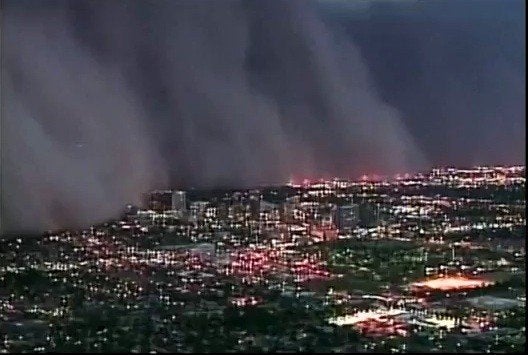
On the evening of July 5, an incredible dust storm -- or "haboob" -- raged through Phoenix, Ariz.:
[The dust cloud] was around 5,000 feet when it arrived in Phoenix, but radar data reveals that it reached heights anywhere from 8,000 to 10,000 feet high prior. The storm appeared to be around 50 miles wide in some areas, KSAZ-TV reported. The dust storm originated in Tucson, and was a part of Arizona's monsoon season.
Photos and video of this massive storm are remarkable to look at. But because my organization, SmartPower, is focused on making Arizona the solar capital of the nation, all I could think about was all those solar panels! Should Phoenix residents be up on the roof dusting them off?
Not necessarily. Even though dust can build up on solar modules, rain that often accompanies dust storms -- or that comes later -- will usually be sufficient for cleaning them off. In most cases, you can let Mother Nature do her work and clean the modules for you.
Here is a simple post-storm checklist:
- Inspect modules after a storm for any damage or debris buildup on or around the array.
A quick inspection after a weather event like yesterday's in Phoenix would be recommended. If your modules are soiled significantly, then give them a quick cleaning. Usually, a simple spray from your garden hose can remove dust, pollen and any bird droppings that may be on your modules. If you have hard water, which is common in the Phoenix area, caution is recommended, as municipal water may contain high amounts of minerals that will end up on your modules after the water evaporates and dries. In other words, you could end up putting just as much dirt back on the modules after your "cleaning." It's best to check with your installer or the solar module manufacturer to verify the best way to clean them.
Beyond haboobs, a regular maintenance plan can -- and should -- be implemented, and you can do this with your installer. This plan should include inspection for environmental parameters, such as dust and shading. If you find that dust and soil conditions near your modules are severe and possibly causing performance issues, you will need to adjust your maintenance plan accordingly.
That's it! A little effort to keep your system clean and in good condition will pay off in better system performance and energy output.
Brian Keane is the President of SmartPower, a non-profit marketing organization funded by private foundations to help build the clean energy marketplace by helping the American public become smarter about their energy use.
